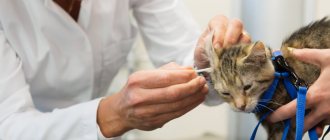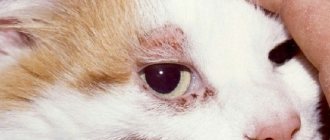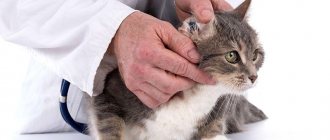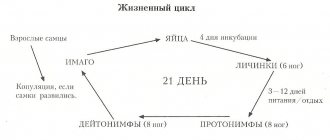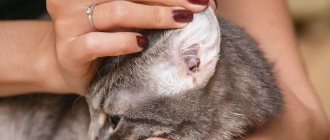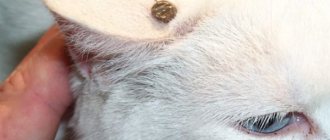The appearance of a parasite such as an ear mite in a cat is the beginning of a serious disease - otodectosis , which must be eradicated at the first symptoms.
The reasons for its occurrence are completely different, but if you follow the basic rules of prevention, infection can be easily prevented. If the cat is already sick, it can be treated with simple manipulations, even at home.
What is otodectosis in cats?
A disease of the outer ear caused by the microscopic parasite Otodectes cynotis, known by such names as otodectosis in cats, parasitic otitis media, ear scabies, and ear mites.
At first, one ear is most often affected, then the disease spreads to the second. When an animal sleeps, it curls up into a ball. Therefore, when a cat has otodectosis, the parasite is able to settle in other areas: the neck, tail, and pelvic area. Outwardly, it may look like dermatitis, allergies, flea bites.
Under good living conditions, proper nutrition, and regular ear cleaning, otodectosis sometimes occurs asymptomatically and goes unnoticed by the owner.
Many cats are carriers of mites without any external manifestations.
However, with deterioration of care, unbalanced feeding, and weakened immunity, ear mites can enter the active stage. Then the disease acutely manifests characteristic symptoms, and treatment directly depends on the condition of the “patient”.
In kittens and young animals the disease is severe. A kitten becomes infected especially quickly from other animals and from its mother.
Clinical symptoms
At the beginning of the disease, the animal has mild itching, the cat begins to behave restlessly, scratch its ears or the area around the ears with its paws, and may itch on various objects in the environment.
An important symptom will be a large amount of earwax and brown dry crusts in the external auditory canal, reminiscent of ground coffee. A large amount of exudate can completely block the ear canal, which will lead to hearing loss .
the eardrum may , which will lead to the development of otitis media and, if the inflammation spreads to the meninges, meningitis . In this case, the animal will exhibit neurological symptoms - an unsteady gait, the head may be tilted to the side, convulsions, and the body temperature will rise. The whole process can be fatal.
Up
Briefly about the pathogen
Otodectes cynotis, the causative agent of the disease, is so small that it is difficult to see with the naked eye. Its body dimensions are approximately 0.2-0.5 mm. However, if you examine with a magnifying glass what an ear mite looks like, you can see slowly moving pale yellow, white dots. The parasite feeds on skin scales from the ear canal of animals. Lives on the surface and does not dig.
The life of a tick lasts 3 weeks:
- Females lay eggs and attach them to the skin with a viscous substance and cement them. Each female lays 5 eggs per day.
- After 4 days the larvae appear. Within 3-10 days they begin to actively feed. Then comes the rest phase (from 10 to 30 hours).
- The cycle changes and the larvae move into different stages of development (protonymph and deutonymph).
- While in the deutonymph stage, the larvae attach themselves to the males. And if the deutonymph is a future female, then when she becomes an adult, she already turns out to be a carrier of eggs.
An adult lives on average 2 months. Life outside the animal lasts approximately 12 days.
The best ear drops
The animal is treated with drugs available in a wide range of veterinary pharmacies. Their choice should be treated carefully, because... Some remedies do not help, others have a temporary effect, and others cause adverse reactions and only complicate treatment.
It is important to consider the age of the animal and its condition. For example, there are drops that are suitable only for adult animals. Other drugs are not suitable for pregnant and lactating cats.
It is important to read in detail the instructions that come with the product. The drops are not harmless and if they are used incorrectly or the correct dosage is not followed, animals can be seriously harmed, especially kittens.
Anandin plus
These drops have no side effects and are inexpensive. A bottle of this product will cost the buyer 50 rubles. It contains active substances:
- decamethoxin;
- amitrazine
The drug not only fights the parasite, but also counteracts fungal and infectious diseases. Its components eliminate:
- irritation;
- itching;
- inflammation;
- infections.
If 1 ear is infected, drops must be instilled into both ears 3 times a day. Therapy should last 7 days, after which the doctor examines the sick animal. If necessary, he will recommend taking a repeat course.
This medication has the following properties:
- anti-inflammatory;
- antibacterial.
Positive results are obvious immediately after the first use of the drug. The product is non-toxic and does not cause any allergic reactions.
Otoferonol gold
This is another effective veterinary drug. It includes:
- cycloferon;
- propolis;
- pyrethroid deltamethrin;
- alcohol.
Application of drops:
- promotes active tissue restoration;
- has an antimicrobial effect;
- stops the inflammatory process.
The medicine contains a toxic component, so it is prohibited:
- pregnant and lactating females;
- animals up to 2 months old;
- cats with infectious diseases;
- animals with weakened immune systems;
Drops are used once a day for a week. The product stings, but the effect is quick.
Dekta
Complex drug, which includes:
- amitraz;
- levomecithin;
- propolis.
The product has the following properties:
- antimicrobial;
- anti-inflammatory;
- wound healing.
It is instilled into the ears of cats, 2-3 drops per day. The course of treatment lasts a week, after which it is necessary to take a break for 7 days. Treatment is carried out until the parasite is completely eliminated.
It is not recommended to use the drug:
- if the cat is pregnant;
- if the kittens are less than 1 month old.
Ectodes
The drug is acaricidal and includes the following components:
- pyrethroid;
- propolis;
- sulfur;
- dimexide.
The included components have the following actions:
- anti-inflammatory;
- analgesic;
- antiseptic;
- fibrinolytic.
2-3 drops per day are instilled into the ears for a week. The only contraindication for this medication is the animal’s hypersensitivity to its components. The drug is used even in advanced cases, when the stage of otitis media begins.
Leopard
Bars drops are easy to use and safe. Thanks to the correctly selected component of the drug - diazinon - it is possible to quickly cope with the problem and achieve a speedy recovery of the animal. Its advantages:
- Does not cause allergies.
- Has antiseptic and anti-inflammatory properties.
- Actively fights pathogens.
- Helps eliminate swelling and itching in a short time.
Already on the 2nd day of using the drops, you can see an improvement in the animal’s condition. In order not to reduce the effectiveness of the product, the procedure schedule must be strictly followed. The use of the product should be stopped immediately if the cat develops the following signs:
- itching;
- redness;
- vomit.
Demos
You can also treat hearing aids with medications in cats using Demos. Its auxiliary components:
- reduce inflammation;
- have an active acaricidal effect;
- promote rapid healing of damaged areas;
- have a detrimental effect on pathogens.
The ears of a sick animal are treated with the product 2-3 times a day. The course of treatment is 7 days. The break should be at least 5-7 days, after which the therapy procedures are repeated until the pet recovers completely.
Mycodemocid
This drug is not the least effective among anti-tick drugs for cats. Apply it 1 time. The animal's ears are treated with the product (1-2 drops), after which they need to be massaged. At an advanced stage of the disease, the action must be repeated after 5 days.
The main component is sea buckthorn oil, under the influence of which parasites die. The drug is non-toxic and safe.
Due to the use of the product:
- trophic processes in tissues improve;
- damaged areas are quickly regenerated;
- the coat is restored;
- the general condition of the animal improves;
- the pet's appetite returns;
- immunity is restored.
Otodectosis in cats: symptoms
To feed, the parasite injures the animal’s skin, from which a liquid is released that serves as food for it. Such microtraumas, as well as secretions and excrement released during life, irritate the skin and cause severe, unbearable itching. To alleviate the condition, the animal constantly shakes its head, scratches its ears with its paw, and rubs them against objects.
Due to mechanical damage to the skin on the back of the head and ears, scratches and abrasions are found, and patches of bald patches may appear. If the eardrum is damaged, the pet tilts its head to the side.
If left untreated, the condition worsens, and inflammation gradually develops - otitis media. Therefore, otodectosis is also called parasitic otitis media.
Over time, the inner surface of the ears turns red, the skin in this area thickens and gathers into folds. If the process is not stopped, the inflammation spreads to the eardrum, the inner ear and further penetrates the brain. In this condition, the pet’s body temperature rises, lethargy, convulsions or seizures appear.
The animal's behavior changes:
- sudden movements appear, running to nowhere;
- meowing when scratching ears;
- The cat presses his ears and does not allow his head to be stroked or his ears to be touched.
To understand what is happening to the cat, the owner needs to examine the ears. It will not be possible to examine the parasites. But the signs of ear mites in cats are immediately clear - an atypical color of plaque and severe itching.
If normally a cat's earwax is light with shades of yellow or brown, then with otodectosis the contents of the ear are dark brown and even black, resembling coffee grounds (as in the photo below).
Sulfur in otodectosis comes in different consistencies: dry, wet, loose, hard, pasty. If there is an inflammatory process, an unpleasant odor comes from the ear.
Rules for cleaning ears at home
Before carrying out the procedure, be sure to clean your cat's ears. This must be done regardless of the drug used, even if there is no such indication in the instructions for it.
As tools you will need:
- cotton pads to remove plaque;
- cotton swabs (it is not recommended to use homemade devices in the form of cotton wool wound around a match, this can cause damage if you are careless);
- cleaning agents (chlorhexidine, hydrogen peroxide, boric acid solution at a concentration of 3%).
Advice: if your pet is not accustomed to this kind of event or has an intractable character, arm yourself with a towel or sheet in which to swaddle the animal.
The sequence of the procedure for cleaning a pet's ears:
- Place the cat on your lap after covering it with a blanket. Calm down. Remember that for the animal, your desire to cure it is still perceived as a stressful situation.
- Gently bend the auricle and wipe the surface from dirt.
- Gently clean the affected area with a cotton swab soaked in a disinfectant solution. Never pick an animal's ear with pressure.
- Apply the drug. Massage lightly.
- Give the cat a chance to shake its head. Afterwards, wipe the inside of the ear and the hair around it with the same composition.
Diagnosis of otodectosis
In a veterinary clinic, the diagnosis is made based on examination and examination of the contents of the ear under a microscope.
Basic methods:
- Using a special instrument, the doctor sees moving white dots.
- Studying sulfur under a microscope allows you to examine adults, larvae and eggs.
- The "positive ear" method. The doctor wipes the ear canal, and the cat reacts by trying to scratch with its hind paw.
If inflammation (otitis media) has developed, diagnosis becomes difficult. The fact is that with otitis media, an acidic environment is created in the ear, in which parasites die. Therefore, microscopy may not show results.
Also, before treating for otodectosis, the doctor must exclude other diseases that lead to inflammation of the outer ear: allergies, flea dermatitis and other types of parasites.
Prevention of infection
It is no secret that preventing any disease, including otodectosis, is easier than treating it. For prevention purposes, the following rules should be observed:
- Carry out regular inspection and cleaning of your pet’s ears;
- avoid contact with suspicious animals;
- strengthen the cat’s immunity by adhering to the principles of proper nutrition, as well as ensuring that the pet takes the necessary vitamins;
- maintain pet hygiene;
- If you suspect the presence of a tick, you should immediately visit a specialist.
How to treat ear mites in cats
Before starting treatment for otodectosis in cats, many factors are taken into account:
- Conditions of keeping (does the cat go outside).
- The severity of the condition.
- Presence of other animals at home.
If there are other pets in the house, then general treatment is carried out. Treatment of the premises and objects is not required, since the parasite does not survive well in the environment. There is also no need to change your diet and lifestyle.
It is more effective to treat otodectosis in a cat that does not go outside and is kept entirely indoors using systemic medications. This is one way to get rid of ticks forever. If the cat is walking and in contact with other animals, parasites are removed with acaricidal preparations that are applied topically.
There is no quick cure for ear scabies in cats. On average, treatment takes 1-1.5 months.
It is important to keep your ears clean throughout your treatment. Otherwise, the cat’s ear mite takes refuge in wax and secretions, and acaricidal agents do not penetrate to the place of refuge.
Folk remedies
It is possible to remove ear mites at home using folk remedies only in the first stages of the disease. In their neglected form they do not produce results.
A well-known method of treatment with folk remedies is the use of sea buckthorn oil. They also use olive, almond, but not tea tree. Some people infuse garlic oil to kill bacteria. Oil may reduce irritation, but it will not get rid of the pathogen.
When ear mites are diagnosed in cats, treatment at home is not recommended. Traditional methods are safe, but ineffective.
Development of the disease
Since the tick feeds on tissue fluid and lymph, in order to get food for itself, it injures the upper layer of the epidermis of the external auditory canal with its chelicerae.
The release of tissue fluid in large quantities leads to the formation of a large number of crusts and scabs, and when microtraumas are contaminated with bacteria, a local inflammatory process (otitis externa) occurs.
In advanced cases, a perforation (rupture) of the eardrum , then the inflammation spreads first to the middle ear (otitis media) and to the membranes of the brain (meningitis), which often ends in death.
Up
Possible complications
With timely treatment, otodectosis does not cause complications.
With a prolonged illness, dangerous consequences are possible:
- Otitis is an inflammatory process accompanied by the release of pus inside the ear. Therefore, if otitis media accompanies otodectosis, then the goal of treatment is not only to destroy the parasite, but to free the ears from germs. For ear mites, cats are prescribed rinsing with antiseptics (dioxidine, chlorhexidine) and a course of antibiotics.
- Hematoma of the auricle. With otodectosis, the pet itches and can damage blood or lymphatic vessels with its claws. If a blood vessel is injured, a hematoma forms. When a lymphatic vessel ruptures, lymph accumulates under the skin. For hematomas in cats, there is no treatment at home, only surgery. The mass is opened and antibiotics are prescribed.
Rules for the use of drugs
Treating a cat for ear parasites requires preliminary preparation. Before the procedure, it is necessary to heat the medicine to a temperature of 25-27 degrees. You should also prepare equipment: cotton pads, bandages or gauze, a solution for cleaning the inside of the ear.
The procedure is carried out as follows:
- The cat is calmed and restrained well. To do this, you can use a durable bag, carrier or thick blanket.
- The cat's ears need to be cleaned of brown deposits. To do this, a special lotion or saline solution is instilled into each ear, the auricle is folded in half and gently massaged. After this, the soaked plaque is removed with a clean cotton pad.
- The amount of the drug indicated in the instructions is instilled into each ear of the cat.
- After applying the drops, the base of the ear is folded and gently massaged so that the medicine is evenly distributed over the surface.
- After treatment, the animal is released. After this, the cat actively shakes its head, and excess drug is removed from the ear.
IMPORTANT! Many cats behave very aggressively during ear treatment, so it is necessary to securely restrain the pet.

